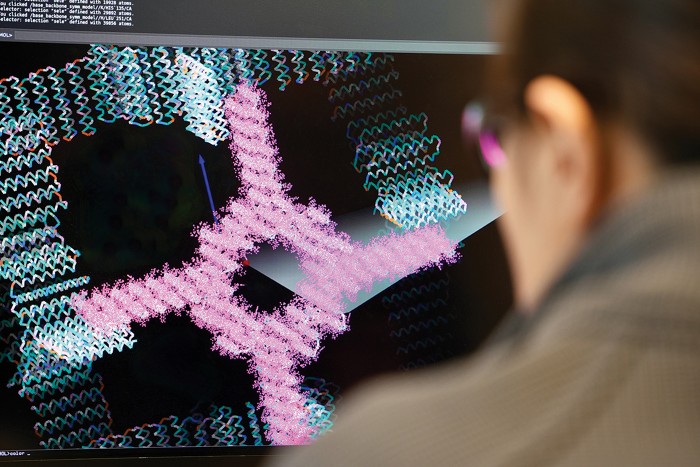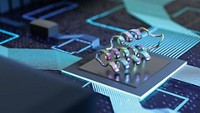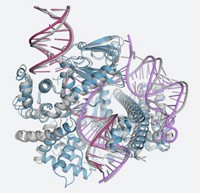Advertisement
Grab your lab coat. Let's get started
Welcome!
Welcome!
Create an account below to get 6 C&EN articles per month, receive newsletters and more - all free.
It seems this is your first time logging in online. Please enter the following information to continue.
As an ACS member you automatically get access to this site. All we need is few more details to create your reading experience.
Not you? Sign in with a different account.
Not you? Sign in with a different account.
ERROR 1
ERROR 1
ERROR 2
ERROR 2
ERROR 2
ERROR 2
ERROR 2
Password and Confirm password must match.
If you have an ACS member number, please enter it here so we can link this account to your membership. (optional)
ERROR 2
ACS values your privacy. By submitting your information, you are gaining access to C&EN and subscribing to our weekly newsletter. We use the information you provide to make your reading experience better, and we will never sell your data to third party members.
Protein Folding
Can biomolecular designers move fast without breaking things?
Researchers hope to use AI to build new protein-based materials and drugs without making it too easy to do harm
by Laurel Oldach
April 10, 2024

New artificial intelligence tools for biomolecular design enable researchers to build completely new proteins. The past month has seen the release of code from at least two new tools for making proteins from scratch (Science 2024, DOI: 10.1126/science.adl2528 and 10.1126/science.adl5364) and reports of scientists using those and other tools to make protein-based nanomaterials, antibodies, and other drug candidates. The field looks set to keep advancing rapidly: According to an analysis from the think tank Epoch AI, the amount of computational resources devoted to training biological sequence models doubles about every 4 months.
While dazzling, these advances also concern biosecurity experts. “It’s very, very hard to separate the benefits from the risks,” science policy consultant Sarah Carter tells C&EN. For example, consider AI tools that could help researchers identify vaccine targets on the surface of a pathogen. “Those are the same tools that will tell you if a certain pathogen protein will escape the vaccine,” Carter says.
On April 3 and 4, experts gathered at the National Academies of Sciences, Engineering, and Medicine to discuss ways to mitigate the risks AI poses without delaying scientific progress. Joseph Buccina of the National Security Commission on Emerging Biotechnology said during the meeting, “I do think one of the chief risks is being over-conservative in this space.” And while other workshop attendees seemed to agree that containing biohazards is critical, several cautioned against overregulating and losing out on the scientific and economic opportunities that AI tools offer.
In March, researchers in the protein design community posted the possible start to an answer, a set of principles for ethical AI research in protein design. More than 160 researchers developing AI tools for biology have signed on, committing to ten research practices that include reviewing new design tools for potential risks before releasing their code and ordering DNA only from vendors who screen their orders.
During a presentation at the NASEM workshop, James Diggans, head of biosecurity at Twist Bioscience, which synthesized some 634,000 genes in 2023, described screening as his company’s way to ask, “Should this design come into the physical world?” Currently, Twist and peer DNA synthesis companies that belong to the International Gene Synthesis Consortium check the DNA they produce for customers against regulated sequences, most of which are from pathogens. The process relies on similarity between sequences to recognize threats—a paradigm that biomolecular design tools threaten to break because they enable the design of molecules with no resemblance to known sequences. Diggans called for the biosecurity community to develop new ways to estimate the risk inherent in producing a given molecule, echoing an executive order on AI. The community, he says, might start by defining the characteristics of a risky molecule. For the moment, experts say that screening the customers who order DNA can act as a backstop. The design community has committed to supporting new approaches to spot dangerous molecules before they are made—for example, by using AI to predict the function of designed proteins.
“Protein design is clearly farther ahead than many other kinds of biodesign tools,” Carter says. But AI tools for synthetic biology and biomanufacturing, which could raise threats of their own, are also developing rapidly. She thinks principles adopted by the protein design community, and the regulations that are imposed, will likely “set the stage . . . for a much wider range of biodesign tools as they become more developed.”




Join the conversation
Contact the reporter
Submit a Letter to the Editor for publication
Engage with us on Twitter